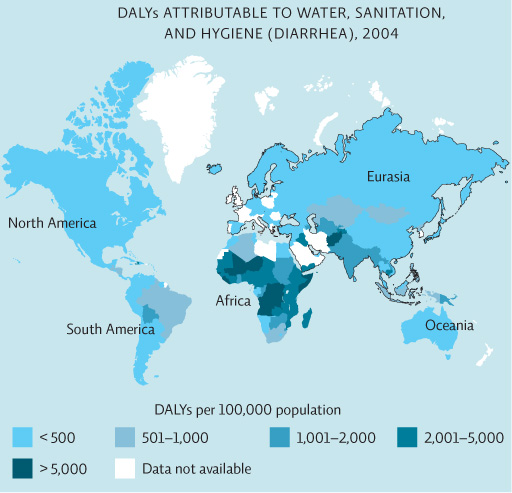SCIENCE LITERACY WORKING WITH DATA
The World Health Organization’s (WHO’s) Global Burden of Disease analysis provides a comprehensive and comparable assessment of mortality and loss of health due to diseases, injuries, and risk factors for all regions of the world. The overall burden of disease is assessed using the disability-adjusted life year (DALY), a time-based measure that combines years of life lost due to premature mortality and time lived in states of less than full health.
Interpretation
1. According to the map, which continent appears to have most problems with the lack of sanitation?
Africa
2. What is the DALY status attributable to water and hygiene in most of the world’s developed countries?
The developed regions of North America and Europe appear to have the lowest level of problems related to water and hygiene (< 500 DALYs per 100,000 population).
3. In your own words, describe the DALY status in Eurasia, one of the most populous areas on Earth.
This includes China and India, two rapidly growing areas, and shows that in India and its neighboring countries there are far more problems with lack of clean water than there are in Western Europe. Afghanistan has the highest DALY rating in Eurasia. China and India do not have the same level of difficulty as countries in Africa, but they still have serious problems with illness from lack of clean water and hygiene.
Advance Your Thinking
4. Explain why people in many places in the United States complain of water shortages, while this map indicates that they have access to clean water and sanitation.
Many places in the United States have clean water and good access to sanitary facilities, but they do not have an unlimited supply of water. This is especially true of dry areas such as the desert southwest but many other areas experience shortages due to high usage rates. Some places limit the days and times that you can water plants, and discourage lawns and ornamental gardens.
5. If much of Africa is grasslands and jungle, why do the inhabitants have so little access to clean water and sanitation?
They may have a rainy season with adequate rainfall and large rivers in some places, but they have no way to access underground aquifers. The surface waters may be filled with sediment and microorganisms that cause disease, or there may not be surface waters easily available. There may not be any way to handle wastewater or sewage, and toilet facilities may be minimal or nonexistent. Roads and equipment may not be available to build treatment plants, dams, or wells.
6. Some countries that border oceans are able to afford desalination plants to improve their access to clean drinking water. If all countries could afford it, would this solve the worldwide problem? Explain.
No, because many countries do not have coasts, so they do not have access to seawater. Many countries do not have the roads and other infrastructure necessary to transport the cleaned water from the coastal areas to inland populations.
